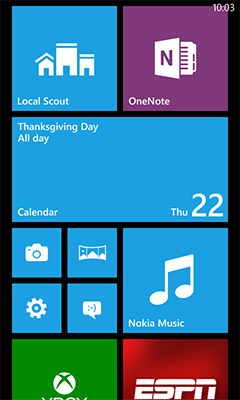
Back ويندوز فون 8 Arabic Windows Phone 8 Tibetan Windows Phone 8 Catalan Windows Phone 8 Czech Microsoft Windows Phone 8 German Windows Phone 8 Spanish ویندوز فون ۸ Persian Windows Phone 8 French Windows Phone 8 HAK विंडोज़ फोन ८ Hindi
| Version of the Windows Phone operating system | |
 Start screen | |
| Developer | Microsoft Corporation |
|---|---|
| OS family | Windows 8 |
| Working state | Discontinued |
| Source model | Closed-source |
| General availability | October 29, 2012 |
| Latest release | Update 3 (Build 8.0.10532.166) / April 14, 2014[1] |
| Update method | Firmware over the air |
| Package manager | XAP, APPX |
| Platforms | 32-bit ARM architecture |
| Kernel type | Hybrid (NT kernel)[2] |
| License | Commercial proprietary software |
| Preceded by | Windows Phone 7 (2010) |
| Succeeded by | Windows Phone 8.1 (2014) |
| Official website | Archived official website at the Wayback Machine (archive index) |
| Support status | |
| Unsupported as of January 12, 2016 [1] | |
Windows Phone 8 is the second generation of the Windows Phone mobile operating system from Microsoft, released on October 29, 2012. It runs on the Windows NT kernel and is the successor to Windows Phone 7. It was the first Windows platform for mobile devices to be closely related to, and match the version number, of a desktop counterpart, in this case Windows 8.[3][4]
Like its predecessor, it features a flat user interface based on the Metro design language. Windows Phone 8 replaced the Windows CE-based architecture used in Windows Phone 7.x with the NT kernel found in Windows 8. As a consequence of this, Windows Phone 7.x devices cannot run or update to Windows Phone 8, and new applications compiled specifically for Windows Phone 8 are not made available for Windows Phone 7.x devices. Windows Phone 8 devices were manufactured by Nokia, HTC, Samsung and Huawei.[5]
Windows Phone 8 was succeeded by Windows Phone 8.1, which was unveiled on April 2, 2014.[6][7] Support for Windows Phone 8 ended in January 2016.[8]
- ^ http://blogs.windows.com/windows_phone/b/windowsphone/archive/2013/10/14/announcing-our-third-windows-phone-8-update-plus-a-new-developer-preview-program.aspx
- ^ Jo Foley, Mary (June 20, 2012). "Microsoft's Windows Phone 8 finally gets a 'real' Windows core". ZDNet. Archived from the original on June 22, 2012. Retrieved December 25, 2012.
- ^ Staff, Ars (November 16, 2012). "Windows Phone 8 review: Microsoft lays a foundation for success". Ars Technica. Retrieved May 12, 2025.
- ^ Ferguson, Tim (November 29, 2012). "Windows Phone sales on the up - Microsoft CEO". Mobile World Live. Retrieved May 12, 2025.
- ^ Nokia, Samsung, HTC, and Huawei will have first Windows Phone 8 devices Archived April 28, 2017, at the Wayback Machine. The Verge. June 20, 2012
- ^ "Microsoft begins sharing Windows Phone 8.1 with developers". The Verge. Vox Media. February 10, 2014.
- ^ "Windows Phone 8.1 includes universal apps and lots of feature updates". The Verge. Vox Media. February 11, 2014.
- ^ Cite error: The named reference
:0was invoked but never defined (see the help page).
© MMXXIII Rich X Search. We shall prevail. All rights reserved. Rich X Search